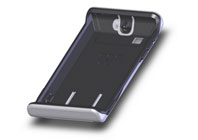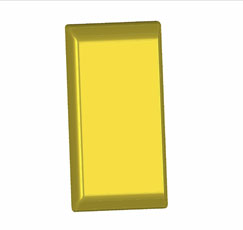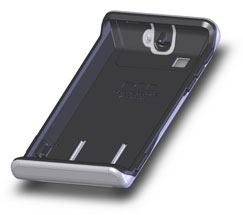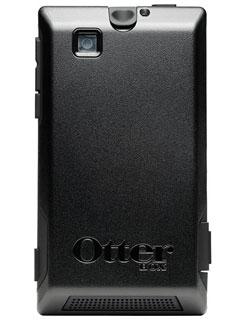In the ultra-competitive mobile device accessory market, getting a new product to market quickly is not only important, but essential. OtterBox uses Geomagic Studio, a Creaform HandyScan and SolidWorks to do it faster than ever

3D scan data of the back and left sides of the
Motorola Devour

Finished surfaces created in Geomagic Studio for importing into SolidWorks CAD software

The finished case designs modelled in SolidWorks for the Motorola Devour

The final product, Otterbox Devour case
Working within the highly competitive field of cases for mobile devices, OtterBox faces the dual challenge of requiring more products within increasingly shorter cycle times. In early 2010, and following a series of frustrations with another high-end reverse engineering package, OtterBox transitioned from outsourcing most of its reverse engineering work to bringing it in-house using Geomagic Studio .
“The first reverse engineering software we tried was like learning a new CAD package,” says Zach Dunkin, OtterBox’s product development technician. “It was difficult to use and the surface offsets wouldn’t work. The time I would have invested in using it effectively would have been too great. In contrast, I was able to generate 13 surfaces for cases that came to market in the first six months of using Geomagic.”
The difference, says Dunkin, is the ability to generate clean, crisp surfaces from scan data of the actual device – whether smart phone, iPod or iPad – for which OtterBox is making a custom case. In the competitive market in which OtterBox plays, there is little room for reworking and the finished product must fit like a glove right out of the box.
A window of opportunity
“We’re in a market where the life cycle of the product is very short – typically 10 to 12 months,” says Alan Morine, OtterBox’s research and development manager. “We have to get the product out quickly or else the market opportunity decreases exponentially.”
The pressure is further increased by the number of products hitting the market and consumers’ hunger for variety. OtterBox started with cases for the BlackBerry and iPhone, but has rapidly expanded to cover other products from Apple, as well as devices from Motorola, Nokia, Palm, HTC and others. To meet that small marketing window, OtterBox products need to come out simultaneously with the devices or only a couple of weeks afterwards.
Morine and Dunkin say that doing scanning and processing in-house removes delays often associated with outsourcing, stemming from difficulties in communicating design intent and fixing problems in SolidWorks that emanated from the scan data. “The scan model has to be smooth and clean when it gets to CAD or else certain things won’t propagate and you have to try multiple approaches to get what you want,” says Morine. “Little bits of time here and there really add up over the course of the design.”
Better quality: half the time
Morine and Dunkin estimate that scanning and processing time has been cut by about half by using Geomagic Studio in-house; from about seven to ten days outsourced to about three to five days in-house. OtterBox’s current approach starts with either a device provided in advance by the OEM for scanning or a CAD model. If a device is supplied, it is scanned using either a Creaform Handyscan or a Laser
Design scanner, then placed in Geomagic Studio to clean up data and create surfaces. If a CAD model is provided, it is still processed in Geomagic Studio, which is faster at removing extraneous data than CAD software, according to Morine.
Bringing the scanning and processing in-house has other advantages over outsourcing, according to Dunkin. “It’s absolutely necessary when you are working on top-secret devices that you cannot send to an outside vendor,” he says. “Doing the work in house also speeds turnaround time and reduces rework throughout the product development cycle. Last, but not least, it improves interaction with designers. We can find out from the beginning what shapes they need and what data we can omit, which saves time. If there is a problem with a surface, I can change it, re-import it to SolidWorks and they have a better working surface, quicker.”
Dunkin primarily uses the design-intent modeller in Geomagic Studio to clean up data and generate surfaces but has also begun using the exact surface modeller to process the higher-precision scans. “The dual-modelling programs in Geomagic Studio give me the flexibility to choose the modeller that’s best for a specific project,” says Dunkin. After surfaces are generated in Geomagic Studio, they are imported into SolidWorks to build surface layers and model product features such as buttons and screens. Once the CAD model is developed and prototyped to the satisfaction of the industrial and mechanical designers, it is sent off for tooling and manufacturing.
Process compression
Doing its reverse engineering in-house is part of an ongoing campaign by OtterBox to shave product development time and add product capacity without compromising quality. Earlier this year, the company’s typical time from initial scanning to having a manufactured product in the warehouse was 10 to 12 weeks. Morine expects OtterBox to soon reduce that time substantially.
“We’re averaging about 10-12 product releases a month, give or take a few,” he says. “We’ll turn out more than 100 products this year and that’s going to keep increasing. We’ll be adding staff, tightening our relationships with OEMs, and using technology tools such as Geomagic Studio to keep compressing the process.” While that might not silence the dual voices of “faster, faster” and “more, more,” it will go a long way to ensuring OtterBox’s continued market leadership in the years ahead.
OtterBox uses Geomagic Studio, a Creaform HandyScan and SolidWorks to get new products to market quickly
No






